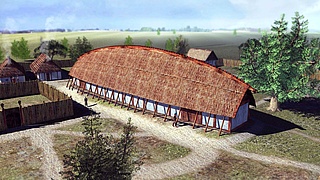Exhibition of the Archaeological Museum and the Danish National Museum
(kus) A special exhibition from February 11 to June 6 is devoted for the first time to the Danish National Museum's new excavations and research on Scandinavian cult sites of the first millennium AD. Precious finds and surprising excavation findings provide insights into the cult practices of the pagan religion of the ancient North. The focus is on Danish princely residences with huge assembly halls up to 50 metres long and their own cult buildings for communal sacrifices. The architectural stagings of these buildings in the Frankfurt museum are spectacular in life-size. A second theme is the north's relations with the continental Frankish Empire and Christianization.
The New Image of the Old Faith
For Pliny the Elder (23 - 79 AD), Scatinavia was an "island of unexplored extent." Unexplored to the ancient world were primarily the inhabitants of Scatinavia and their religion. 1200 years later, Christian scholars coming from Iceland brought the Old Norse myths and with them important information about Old Norse paganism to parchment. This was essentially the basis of our knowledge of the pre-Christian religion of the North until recent times. However, there were hardly any established facts about religious practice, about sacred buildings and places, and about the social function and organization of religion.
New excavations and research projects
First extensive excavations in Scandinavia in recent years now allow deeper insights into cult practice and sacrificial rituals of the pagan religion. Mainly in Denmark and Sweden, quite a number of large residences of regional rulers of the first millennium AD have been excavated - all with cult areas, temple buildings and sacrificial sites. In particular, the large-scale excavations of the early medieval princely residence at Tissø on Zealand yielded a wealth of finds and features.
The excavations have been accompanied since 2010 by a long-standing research project at the Danish National Museum on pre-Christian cult sites and Old Norse paganism, led by Prof. Dr. Lars Jørgensen initiated and directed.
Cult and Rulership
Since the turn of the last century, there have been large-scale residences of chieftains, princes, and petty kings in the various landscapes and regions of Scandinavia; they formed centers of larger dominions. At the centre of these residences were huge, white-walled halls up to 50 metres long, comparable in size and function to the throne halls (aula regia) of Carolingian palaces. These large halls were associated with sacred, enclosed cult areas in which temple buildings were erected. In these the great supra-regional seasonal sacrifices were performed, in which all members of the regional cult community were obliged to participate.
Cult practice was thus closely intertwined with noble rule. The "prince" was in personal union secular ruler and cult leader, his "regnum" enclosed at the same time the space of a cult community - the "prince" was rex et sacerdos and he functioned as pontifex maximus - like the Roman emperors since Augustus. Rulership and politics were religious, religion was political.
This dual function of rulership and cult is exemplified by a huge choker of eight braided gold strands found south of the Tissø residence. Measuring 34 centimeters in diameter and weighing about 1,800 grams (originally about 2,000 grams), it is the largest gold bracelet of the Viking Age. It was certainly worn only on special ceremonial occasions by the ruler and cult leader and probably adorned a statue of the gods in the meantime, as known from antiquity. The central importance of communal sacrifice is demonstrated in the exhibition with the runic inscription on the stone from Stentoften in southern Sweden, a human sacrifice from Hundstrup Moor, and other sacrificial finds from Zealand.
The residences of Hoby, Gudme and Tissø
The early manors of Hoby (Lolland; c. Chr. B.C.) and of Gudme (Funen; 3rd-6th century A.D.) are presented with new 3D film reconstructions of the sites and most precious grave and treasure finds. At the centre of the exhibition is the royal residence of Tissø (Zealand; 6th to 11th century AD). A highlight here is the architectural staging of the cult building and the huge assembly hall in natural size. A large number of rare and fascinating finds of the Old Norse cult of sacrifice and gods, including figurines of the main deities Odin, Thor and Freyja, as well as of aristocratic life (retinue, women, feasts, hunting, crafts, trade) impressively illustrate the outstanding function of this place.
The Frankish Empire and the New Faith
With the protracted, eventful adoption of Christianity from the 9th century onwards, the north also became part of Christian Europe. The preceding period of the 6th to 9th centuries was marked by close contacts between Scandinavian and Frankish elites. Between the Nordic manors and the Frankish royal courts and palaces on the continent, such as Frankfurt and Ingelheim, there are striking parallels in terms of construction and function. With the noble child tomb from Frankfurt Cathedral and the royal boat-chamber tomb from Haithabu, singular testimonies to these profound personal relationships are presented.
Accompanying programme and admission
An extensive accompanying programme provides in-depth and entertaining insights into the world of the gods of the pagan north and presents current archaeological and runological research results with guest lectures by renowned experts. Children can also discover the world of the gods of the Viking Age with the puzzle booklet for the special exhibition "Odin, Thor and Freyja". A small reward awaits at the ticket office.
Children and young people under 18 are admitted free of charge. Adults pay regular admission (7, reduced 3.50 euros). On the last Saturday of every month, admission is free. There are public tours of the special exhibition on Sundays at 2 and 3.30 pm, Wednesdays at 6 pm. The guided tour is free of charge, regular admission applies. For information and to register for tours for adults, children, and schools, call (Tuesdays through Fridays from 10 a.m. to 1 p.m.) 069/212-39344 or email fuehrungen.archaeologie@stadt-frankfurt.de









